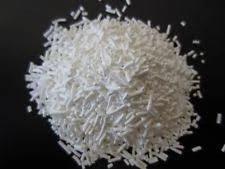
acetic acid and formic acid
Understanding Acetic Acid and Formic Acid Properties, Uses, and Applications
Acetic acid and formic acid are two essential carboxylic acids that play significant roles in various industrial and biological processes. While they share similarities due to their acidic nature, their structures, properties, and applications differ profoundly.
Chemical Structure and Properties
Acetic acid, also known as ethanoic acid, is a simple carboxylic acid with the chemical formula CH₃COOH. It is best recognized as the primary component of vinegar, comprising about 4-8% acetic acid by volume in culinary applications. Acetic acid is a clear, colorless liquid with a pungent smell. It possesses a boiling point of 118 °C and is soluble in water, making it a versatile solvent.
Formic acid, on the other hand, is the simplest carboxylic acid, with the chemical formula HCOOH. It is not only found in nature but also produced synthetically. Formic acid has an even stronger odor compared to acetic acid and has a boiling point of 100.8 °C. Like acetic acid, it is also soluble in water, and it is noted for its strong acidic strength and ability to act as a reducing agent.
Natural Occurrence and Production
Both acids occur in nature. Acetic acid can be found in various natural products, especially in the fermentation of sugars by yeast or bacteria. It is produced industrially on a large scale through the process of methanol carbonylation or through the oxidation of acetaldehyde.
Formic acid is predominantly found in the venom of ants and in the secretions of certain plants. It is produced industrially by the hydrolysis of methyl formate or through the carbonylation of methanol in the presence of water.
acetic acid and formic acid

Applications in Industry
Acetic acid is used widely in the production of food additives, especially as a preservative and flavoring agent. Its ability to inhibit the growth of bacteria makes it a valuable ingredient in food preservation. Additionally, acetic acid is a key raw material in the manufacturing of various chemicals, such as acetate esters, which are used in the production of synthetic fibers, plastics, and coatings.
Formic acid finds its application in different industries as well. It is utilized in leather production, textiles, and as a preservative in animal feed. Its strong reducing properties make it useful in the textile and dyeing industries, while its effectiveness as a cleaning and descaling agent has made it popular in metal processing.
Health and Safety Considerations
While both acids are valuable across multiple industries, they pose certain health risks if not handled properly. Acetic acid can cause skin and eye irritation, and in high concentrations, it is corrosive. Similarly, formic acid is also hazardous; it can cause severe burns and respiratory issues if inhaled. Proper safety equipment, including gloves and goggles, should always be used when handling these substances.
Conclusion
Acetic acid and formic acid are two vital carboxylic acids with distinct properties and applications across various sectors. From their roles in food preservation to their significance in industrial chemical processes, these compounds showcase the incredible utility of organic acids in everyday life and industry. Understanding their characteristics and handling them safely is crucial for harnessing their benefits while mitigating risks associated with their use. As we continue to explore and innovate with these substances, their importance in both agricultural and industrial realms will undoubtedly grow.
-
Why Glacial Acetic Acid Food Grade Is Essential in FlavorNewsMay.26,2025
-
Surging Export Growth of Food Additives in ChinaNewsMay.26,2025
-
How Ammonium Nitrate Fertilizer Boosts Crop YieldsNewsMay.26,2025
-
How 1,2,3-Benzotriazole Shields Plastics from UV DegradationNewsMay.26,2025
-
Cyanide in Gold Mining: Protecting People and the PlanetNewsMay.26,2025
-
Aluminum Hydroxide in Modern Sunscreen FormulationsNewsMay.26,2025
-
Understanding Synthetic Rubber OptionsNewsApr.27,2025
Hebei Tenger Chemical Technology Co., Ltd. focuses on the chemical industry and is committed to the export service of chemical raw materials.
-

view more DiethanolisopropanolamineIn the ever-growing field of chemical solutions, diethanolisopropanolamine (DEIPA) stands out as a versatile and important compound. Due to its unique chemical structure and properties, DEIPA is of interest to various industries including construction, personal care, and agriculture. -

view more TriisopropanolamineTriisopropanolamine (TIPA) alkanol amine substance, is a kind of alcohol amine compound with amino and alcohol hydroxyl, and because of its molecules contains both amino and hydroxyl. -

view more Tetramethyl Thiuram DisulfideTetramethyl thiuram disulfide, also known as TMTD, is a white to light-yellow powder with a distinct sulfur-like odor. It is soluble in organic solvents such as benzene, acetone, and ethyl acetate, making it highly versatile for use in different formulations. TMTD is known for its excellent vulcanization acceleration properties, which makes it a key ingredient in the production of rubber products. Additionally, it acts as an effective fungicide and bactericide, making it valuable in agricultural applications. Its high purity and stability ensure consistent performance, making it a preferred choice for manufacturers across various industries.











